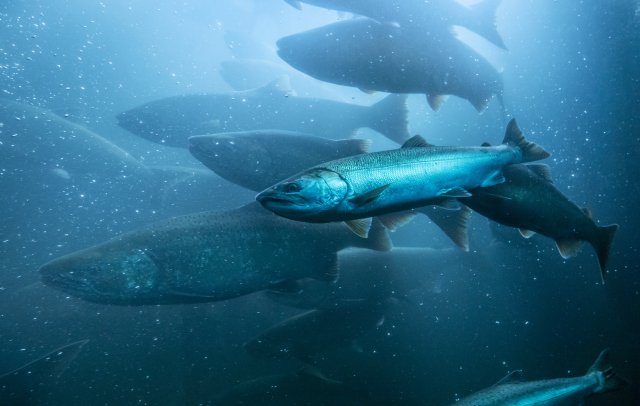6PPD-quinone
What is 6PPD-quinone?

Vehicle tires contain the chemical known as 6PPD to prevent tires from breaking down due to reactions with ozone and other reactive oxygen species in the air. When 6PPD reacts with ozone in the air, it forms 6PPD-quinone. Tires wear down through contact with roads, releasing particles into the environment. When it rains, stormwater from hard surfaces like parking lots and streets washes these particles into streams and other water bodies. As a result, 6PPD-quinone may be present and aquatic organisms can be exposed to it.
Available information on 6PPD-quinone indicates that it is toxic enough to quickly kill some fish. A 2021 publication in the journal Science linked coho salmon death to 6PPD-quinone in stormwater. Concentrations in stormwater were found to be lethal for coho salmon following exposures lasting only a few hours. Subsequent work identified some other fish species as vulnerable to 6PPD-quinone.

The potential of 6PPD-quinone to have ecotoxic effects and impact salmon populations is a key issue. These fish species have cultural, commercial, and ecological importance, and some coho salmon populations are endangered and threatened. Many Tribes rely heavily on salmon and other aquatic resources for food and cultural practices. Healthy and accessible salmon populations are critical to the health and wellbeing of Tribes, including the practice and protection of Tribal Treaty Rights.
Limited information is available regarding emissions, fate and transport, and human health effects of 6PPD-quinone. Research regarding promising stormwater treatment options, such as engineered green infrastructure systems, is ongoing. EPA's researchers and partners across the country are working hard to address these information gaps about 6PPD-quinone. This information will help EPA and state, local, and Tribal partners make more informed decisions on how best to protect human health and the environment.
Key EPA Actions to Address 6PPD-quinone
EPA coordinates with partners and stakeholders to understand, address, and communicate about issues like 6PPD-quinone, and to raise awareness and provide funding opportunities.
In 2024, EPA developed an agency-wide Action Plan that will focus and coordinate activities across EPA’s programs.
EPA activities include:
- Building awareness with Tribal partners through EPA sponsored Tribal Partnership Groups and other mechanisms;
- Conducting research to address data gaps, including work on tire wear emissions, fate and transport, ecotoxicity, and management solutions to mitigate stormwater contamination (for additional information on ongoing research, please contact us);
- Providing grant support to investigate stormwater and 6PPD-quinone data gaps through EPA’s Puget Sound Geographic Program;
- Providing funding to support implementation of stormwater management practices including green infrastructure via the Clean Water State Revolving Fund. This includes $1 billion from the Bipartisan Infrastructure Law specifically for addressing emerging contaminants;
- Case Study of a CWSRF-Eligible Emerging Contaminants Project: City of Seattle (Washington) Public Utilities South Thornton Natural Drainage System Installation
- Developed a draft laboratory method for detection of 6PPD-quinone in surface water and stormwater (Draft EPA Method 1634);
- Developed final screening values for 6PPD-quinone and 6PPD to protect sensitive salmon and other aquatic life;
- Responding to a petition from the Yurok Tribe, the Port Gamble S'Klallam Tribe, and the Puyallup Tribe of Indians to take action on the use of 6PPD in tires.
- Learn more and read the Advance Notice of Proposed Rulemaking for 6PPD and 6PPD-quinone that was published in response to the petition.
-
Providing funding to support development and commercialization of rubber anti-degradant technologies for tires and other rubber products that are of lower concern for human health and the environment through a 2024 Small Business Innovation Research (SBIR) award;
- Participating in and partially funding the Interstate Technology and Regulatory Council (ITRC) 6PPD-quinone team to identify and translate research in cooperation with states, Tribes, and other external entities;
- Participating with federal partners in a National Science and Technology Council (NSTC)/National Toxicology Program (NTP) Working Group on 6PPD-Quinone; and,
- Coordinating with federal partners, Tribes, states, and industry.
6PPD-quinone Resources, Data and Tools
The science on 6PPD and 6PPD-quinone continues to evolve. EPA supports new science in a variety of ways and will continue to update this page as we learn more.
EPA Data Resources
- CompTox Chemicals Dashboard: 6PPD
- CompTox Chemicals Dashboard: 6PPD-quinone
- ECOTOX Knowledgebase: 6PPD and 6PPD-quinone
- ChemExpo Knowledgebase: 6PPD
- Recent EPA publications about 6PPD and 6PPD-quinone
EPA Funding Opportunities
- Clean Water State Revolving Fund (CWSRF), including the appropriation to address emerging contaminants.
- Clean Water Indian Set Aside (CWISA), including the appropriation to address emerging contaminants in tribal communities.
- Funding to protect and restore Puget Sound, including supporting stormwater and 6PPD research via federal interagency agreements (e.g. with the National Oceanic and Atmospheric Administration and the US Geological Survey) and funding for state and academic research teams. See the EPA-funded Puget Sound Stormwater Strategic Initiative for additional funding opportunities.
External Resources
- United States Geological Survey
- Washington State Department of Ecology
- Puget Sound National Estuary Program: Stormwater Strategic Initiative
- California Department of Toxic Substances Control
- Coho Urban Runoff Mortality Syndrome Interactive StoryMap
- Interstate Technology and Regulatory Council (ITRC) Overview of 6PPD and 6PPD-Quinone
